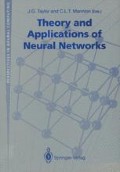Abstract
This paper introduces the application of locally connected computing cells for distributed parallel processing. Cellular Automata are presented as a model of ultra fine grain parallelism, and a brief introduction to their notation and application provided. A machine architecture developed at the University of York, the Fuzzy Automata Machine (FAMe) is presented, and its application to Cellular Neural Networks discussed.
Access this chapter
Tax calculation will be finalised at checkout
Purchases are for personal use only
Preview
Unable to display preview. Download preview PDF.
References
J von Neumann. Theory of self reproducing automata. University of Illinois Press, Illinois, 1966.
K Preston and M Duff. Modern cellular automata. Plenum, London, 1984.
Toffoli and Margolus. CAM a new environment for modelling. MIT Press, Cambridge, Mass., 1986.
W D Hillis. The Connection Machine. MIT Press, Cambridge, Mass., 1985.
anthracene. Technical report, Crystallography Unit, University College, London, 1985.
U Frisch, B Hasslacher, and Y Pomeua. Lattice gas automata for the navier-stokes equation. Physics Review Letters, 56, 1986.
T Toffoli. Cellular automata as an alternative (rather than an approximation to) differential equations in modelling physics. Physica, 10D, 1984.
J Rothstein. Bus automata, brains and mental models. IEEE Transactions on Systems, Man and Cybernetics, 18, 1988.
L O Chua and L Yang. Cellular Neural Networks: Theory. IEEE Transactions on circuits and System, 35 no 10.: 1257, 1272, 1988
S Wolfram. Theory and Applications of Cellular Automata. World Scientific Publishing Co., 1986.
S Y Kung. VLSI Array Processors. In Systolic Arrays. Adam Hilger, 1987.
R Taylor. The use of structural dissipation and replication to provide high virtual connectivity within local automata algorithms. IEEE Transactions on Computers, submitted.
M J Johnson, N M Allinson, and K Moon. Digital Realisation of Self Organising Maps. In Advances in Neural Information Processing Systems. Morgan-Kaufmann, 1984.
D Parkinson. The Distributed Array Processor (DAP). Computer Physics Communications, 28: 325–336, 1983.
T Legendi, E Katona, J Toth, and A Zsoter. Megacell machine. Parallel Computing, 8, 1988.
L Zadeh. Fuzzy logic. IEEE Transactions Computers, April 1988.
Acorn. ARM Datasheet. Acorn Computers Ltd, Cambridge, 1987.
D M Goodeve and R W Taylor. A communications co-processor for the Acorn RISC Machine. Journal of Microprocessor and Microsystems, pages 301–305, July 1990.
TRW LSI Products. CMOS Image Resampling Sequencer. TRW LSI Products, PO Box 2472, La Jolla, CA 92038, 1989.
C A R Hoare. Communicating Sequential Processes. Communications of the ACM, 666, 1978.
Inmos. occam Reference Manual. Prentice Hall, London, 1987.
R W Taylor and S Ghatak. Parasol: an interactive parallel development and debugging environment for the SUN workstation. Technical Report YEE-1/89, Department of Electronics, University of York, 1989.
Inmos. The Transputer Reference Manual. Prentice Hall, London, 1989.
Editor information
Editors and Affiliations
Rights and permissions
Copyright information
© 1992 Springer-Verlag London Limited
About this paper
Cite this paper
Taylor, R.W. (1992). Virtual Connectivity through Structural Dissipation; Parallel Distributed Computation with Local Connectivity. In: Taylor, J.G., Mannion, C.L.T. (eds) Theory and Applications of Neural Networks. Perspectives in Neural Computing. Springer, London. https://doi.org/10.1007/978-1-4471-1833-6_10
Download citation
DOI: https://doi.org/10.1007/978-1-4471-1833-6_10
Publisher Name: Springer, London
Print ISBN: 978-3-540-19650-1
Online ISBN: 978-1-4471-1833-6
eBook Packages: Springer Book Archive

